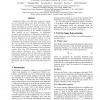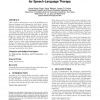87 search results - page 14 / 18 » Computer Vision, Inspired by the Human Brain |
ICCV
2009
IEEE
15 years 11 days ago
2009
IEEE
We present an activity recognition feature inspired by
human psychophysical performance. This feature is based
on the velocity history of tracked keypoints. We present a
generat...
CVPR
2008
IEEE
14 years 1 months ago
2008
IEEE
Inspired by Weber's Law, this paper proposes a simple, yet very powerful and robust local descriptor, Weber Local Descriptor (WLD). It is based on the fact that human percept...
ICPR
2008
IEEE
14 years 1 months ago
2008
IEEE
This paper identifies a novel feature space to address the problem of human face recognition from still images. This is based on the PCA space of the features extracted by a new m...
EUROGRAPHICS
2010
Eurographics
14 years 4 months ago
2010
Eurographics
This paper presents a novel interactive approach for adding depth information into hand-drawn cartoon images and animations. In comparison to previous depth assignment techniques ...
ASSETS
2010
ACM
13 years 7 months ago
2010
ACM
After a stroke or brain injury, it may be more difficult to understand language and communicate with others. Speechlanguage therapy may help an individual regain language and cope...


